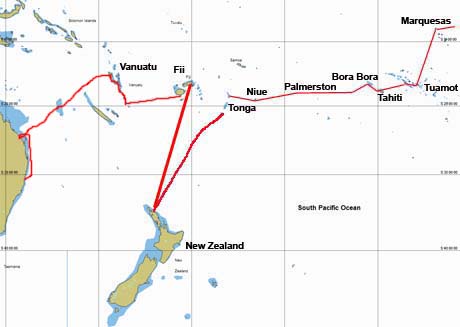
Travel log from Necessity
From Tanna, Vanuatu
Going north on Vanuatu
To Australia
Norway
Home
The Pacific 2007
Vanuatu to Australia

Pictures and video:
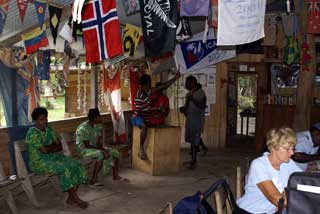
Checking in at the Yacht Club, string band playing
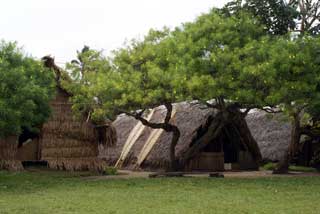
All traditional in Resolution Bay
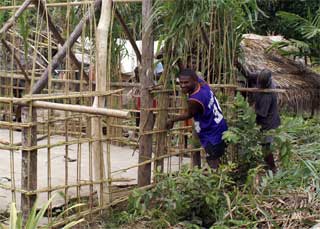
House building in Tanna - framing CC15 (approx)
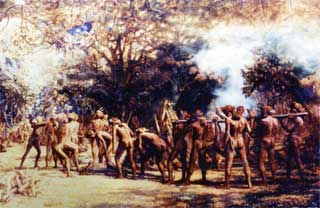
The cannibals were at it until recently, here 130 years ago.
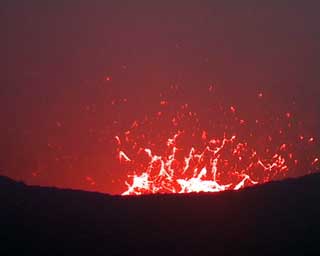

This volcano is very much alive Video
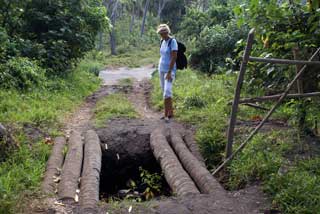
The main road from Port Resolution to Lenakel
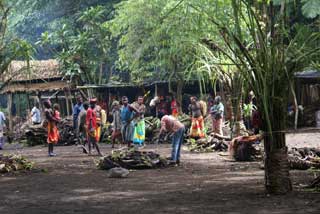
The circumcision feast is being prepared - the piles contain food
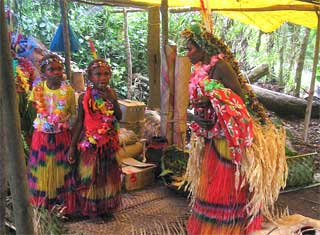
While we wait for brother to come out of isolation
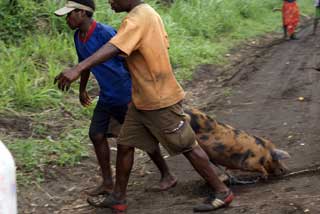
Tough life for the pigs - this one is still alive (we will spare you the sound)
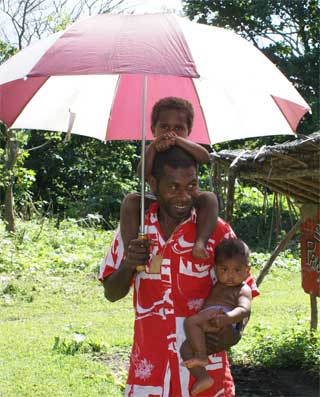
Vanuatu has the happiest people in the world (source "UN")
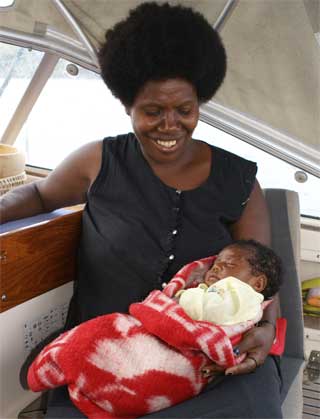
Jocelyn with daughter on board
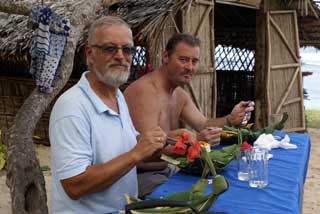
Beach restaurant on Tanna, Tore & Jan Fr.
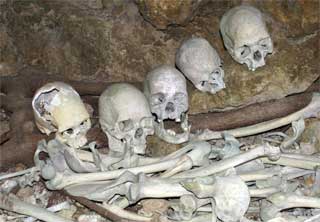
Among the ancestors on Erromango
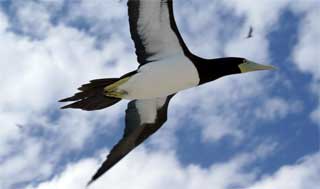
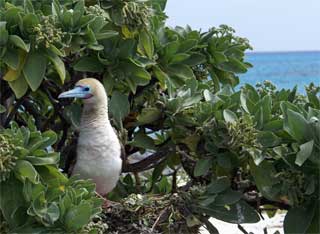
The birds on Chesterfield reef
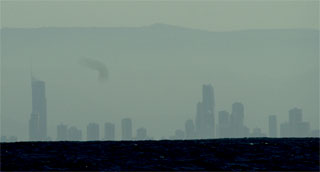
Surfers Paradise seen from the sea. Carracteristic "bar code"
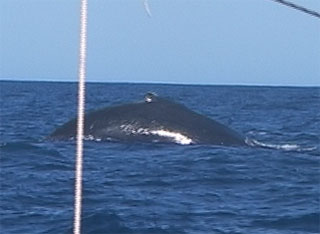
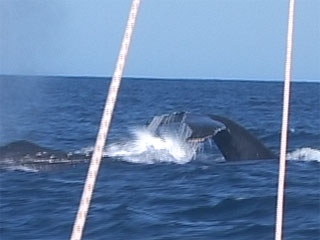
Humpbacks inspecting Necessity
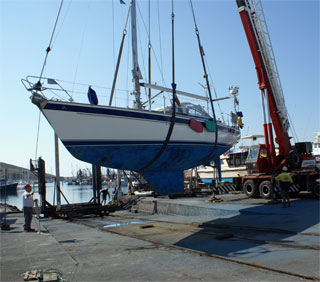
Up on the hard in Coffs Harbour
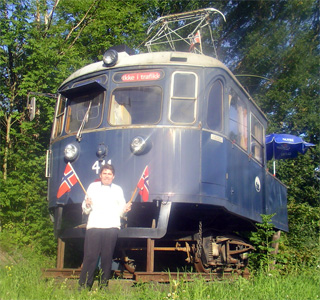
Norwegian environmentalism is mostly symbolic

"Elbilen" Rewa er en av flere løsninger for by og forstadsbruk. Det viktigste er visst å diskutere hvorvidt dette er en bil eller en motorsykkel. For meg virker det ypperlig å kunne benytte kollektivfeltet, komme gratis gjennom bomringen og utnytte delvis gratis parkering på minimalt med plass. Ikke koster den mye heller. Think er muligens bedre, men desverre også vesentlig dyrere.
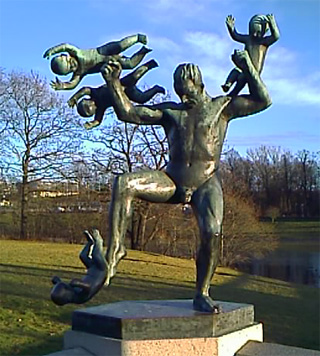
To be children in Norway
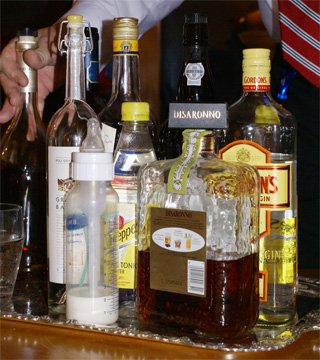
Christmas celebrations for all
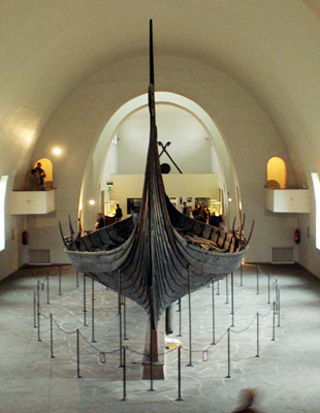
Superb
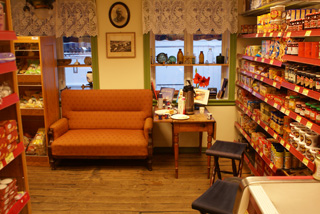
The shop in Lyngør sells groceries and a good chat
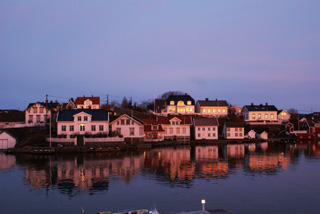
Early morning across Lyngør harbour
Jfm 24.08.07 top
Info: We proceed to Australia this year. Japan & Alaska must wait till 2008-2009.
We have complained that our trip is beginning to feel a bit routine. Nothing is routine here in Vanuatu, including coming here. The weather map showed a little more wind than ideal, but nothing extraordinary. That turned out to be true, but the sea was a roller coaster. Eva was fed up and I didn't like it much myself. There actually was no danger. Our vessel can easily cope with the G forces, but its contents, that is us, was shaken and stirred in the most confused sea we have experienced in a long time. Fortunately the passage was fast even if we had to put the brakes on. You are ill advised to arrive in Port Resolution in the dark even if the glow from the local volcano shows you the way to Tanna. Some comments from other boats arriving just behind us: "Worst we had since we left Holland" (Tatoufo), "I could have broken my neck when I fell down the stairs" (Catanne). After that kind of passage arriving is that much sweeter. The reception was fantastic.
Checking in is seldom enjoyable. Customs and Immigration personnel are often self important and frequently looking for tiny errors and mistakes. The threat of a fine is often there. Not in Tanna. Port Resolution is not a Port of Entry, but every Thursday Customs and Immigration take a truck across the Island to check in the few yachts that come in. We arrived on a Friday and were delighted to find the officials being one day late. The proceedings took place in the "Yacht Club" to the happy tunes of a local string band. The Yacht Club was swinging, and three hours after arrival all formalities were completed. We then took off for the local village.
We found what we are constantly looking for, but seldom find. The people of Tanna are living in accordance with their old ways with only a moderate modernisation. Concrete and corrugated iron seems to be taboo (taboo is originally a Melanesian / Polynesian word), and they probably can't afford it anyway. Vanuatu is a very poor country. We haven't seen villages like these since San Blas.
These villages are fairly large and entirely in traditional style, very tidy and in many ways beautiful. Tracks and meeting places are swept every day. The only break with tradition (kastom) is the dress code. People use T-shirts and shorts/skirts. They mostly appear to be a little dirty, but that is because of the black volcanic sand and the soot from the volcano that is everywhere. Quite elaborate and colourful costumes are used when there is a feast or a celebration. It is a little like carnival, and it makes a strong impression.
We were rightly impressed with the Fijian people. The people in Vanuatu are similar, but a little more reserved. If you address them, however, they are ever so friendly. There is no rush of canoes trying to sell whatever they have, although the odd canoe comes out. He just sits there whistling a low tune. If you want a visit, you wave him over (there are no women in the canoes here). They are very courteous and interesting guests, and we have never had a problem having them on board. They may suggest a little bartering with batteries, cloth and T shirts high on their wish list. In return they provide bananas and roots with the odd lobster and fish thrown in. Begging is very rare in this very poor country. We learn a lot about their society from our often long discussions with these friendly people.
Language is not a problem here. Most speak reasonably good English and often French. Vanuatu, or New Hebrides as it was called by the Europeans, was initially total chaos. This small island group had more than one hundred languages. The French and Brits didn't make it simple either. They couldn't quite agree who should govern Vanuatu so they decided to govern together. Brits and French together? You must be joking. It turned out they were. Little Vanuatu ended up with two parallel governments, two police forces, two sets of laws, two sets of schools, two of nearly everything. And of course two new languages. Used to as they were to numerous languages, the Ni-vanuatu took on the challenge. If a mother speaks English, the first child is sent to a French school, the next goes to the English school etc. There is always one English and one French school in the neighbourhood. This may seem overzealous after the Europeans have handed the country back to its people, but the system is kept to the benefit of the visitors. Nowadays the official language is Bislama, a pidgin English with a touch of French and Micronesian grammar. It is fun to listen to and better to read:
Tankyu - Thank you
Nambawon
- Very good, the best (number one)
Solwota - Sea (salt water)
Basket blong pikinini - womb (basket belonging to child)
Bislama is crucial. We are often shown around by one of the natives. His or her native tongue doesn't last 10 miles, and we are not speaking of dialects. It is surprising that the country is perceived as one. Not long ago it wasn't. The villagers had to be very careful. In the next village they were among the favourite dishes. We have never visited a place were cannibalism was so ingrained, and the villagers were frequently on the war path. How did Vanuatu suddenly become so peaceful? Maybe the missionaries deserve some credit, although many of them ended up in the stew. Cannibalism was practiced as late as the 1960s, to the despair of the colonial powers. This had to end. After lengthy negotiations with the big chiefs, it was decided that it was time to stop. One poor villager was duly eaten to settle old scores, and that was it. Voila, today visitors are welcome on the right side of the plate so to speak.
Today the Ni-Vanuatu are nominally Christian, but perhaps not in a conventional way. When the American forces left the islands in 1945/46 enormous amounts of military equipment was left behind. The locals got rich on junk with some useful items thrown in. This was greatly appreciated, but even the useful items got worn out and disappeared. Nothing more arrived, which must have been due to some displeased spirits. A new cult sprung up, "the Cargo Cult" or John From as it was also called. If they behaved like white people, useful items would appear. By now the believers are a little impatient, but in some villages the hope lives on. Mostly, however, Ni-Vanuatu stick to their old beliefs in combination with Christianity.
Their own beliefs are very visible and also concern visiting sailors. For a few days we had a forecast of strong winds from the north, quite a nuisance and may be dangerous in Port Resolution. We might be forced to leave for a safer anchorage. The locals didn't want this and over the Kava bowl the spirits were consulted. The day after they could assure us that the winds would be light. With such a forecast we of course decided to stay.
Many places are made taboo, something that is taken very seriously by the locals. We have been a little concerned that we unwittingly may transgress and be severely punished. The natives become a little evasive when asked, but assure us that the spirits will probably be more lenient with us. And on Sunday they go to church.
At night there is a red glow over the bay. This is due to Mt. Yasur, the local volcano, lighting up steam and smoke that hang over the top. At the beach steam comes out of crevices in the rocks. In the twilight it is easy to see why the natives are superstitious. We would have felt unsafe if it wasn't for the fact that the volcano has been like this for years. The activity level is 3, which is average. In the nineties it was at level 5 and people were killed by stones and lava being thrown far a field. Even today some stones end up on the main track between Port Resolution and the main village of Lenakel. Thus level 3 is sufficient for a decent dose of adrenalin. One evening we took a pickup truck up close to the volcano. Day light was fading as we approached the rim. We stayed until it was pitch black, although that is an inappropriate expression since it was quite red with a spectacular firework thrown in at regular intervals. The fire works were accompanied by a loud breathing sound, "the Dragons Breath". The experience was a highlight and difficult to put into words. We let the pictures and the video tell.
If the volcano is colourful, so are some of the festivities in Tanna. On a tour to Lenakel, the "capital", we stumbled into a circumcision ceremony. Only the boys are targeted, but it can be bad enough. Everything is "kastom" which means that modern scalpels are out. The local scalpel is instead made of bamboo. Fortunately the actual operation took place a month before our arrival. The other kids laugh and tell us that when the actual incisions take place they have to make as much noise as possible, so that the mothers do not hear the screams of their children. Once circumcised the victims are isolated for a month in a cleansing process, after which they are mostly ok again. The feast can begin. That is when we arrived.
The four families of the circumcised boys had their "tents" around a big clearing in the jungle. The women were dressed up in very colourful robes. Out of the jungle came family and village members in a constant stream with gifts, mostly food. The gifts may be roots like yam or kasawa and lots of kava (pepper root). It may also be slaughtered or live pigs or the finished product laplap, the national dish consisting of pigs or chicken cooked in banana leaves with other roots. The dance would, unfortunately, begin much later, and we were not strictly invited. Even so, we got a glimpse into something quite unique in Vanuatu culture.
Our new crew, Tore, arrived in this unique country directly from the west. We hope and believe that he will enjoy his stay onboard. We took him straight to our local "lunch restaurant". This is a straw hut on the beach with a fireplace and a gas cooker. Lea and Sarah are running the place and cook rice, meat, bananas and numerous roots in banana leaves. It is delicious. It is the closest we get to "civilisation", and the setting overlooking a white beach and blue lagoon is fantastic.
We were on our way back to the boat. Suddenly, out of the jungle, came 8-10 "warriors" running fast. Fortunately they were not on the warpath, but simply hunting wild pigs. The weapons were traditional: long spears, clubs and machetes. Some were tracking and some tried to encircle the prey. Unfortunately our camera was in our backpack. This time the pig escaped. It is hardly an overstatement to say that Tore was stunned by this version of the "autumn hunt" (Tore is a keen hunter).
As we linger in Port Resolution we make more friends. We learn about their society even if it is hard to understand the nuances. Like in many other parts of the 3rd. world the population is a combination of sophisticated and naive. They have a lot of knowledge, and most adults can easily place Norway on the map. Politics and social systems are frequent topics of discussion. They are well aware that Vanuatu has been elected the most happy nation by the UN (even if this is strictly speaking a misunderstanding since it is based on a very odd combination of UN statistics). They are proud and don’t question this assessment even if they are also well aware that Vanuatu is one of the poorest nations in terms of money.
Jocelyn is one of our new friends. She is married to one of the more powerful chiefs, Sam. She is ambitious on behalf of the village and her own family. The dream is tourism on a bigger scale. If anyone can do it, it is Jocelyn. One day Sam, Jocelyn and the youngest daughter came on board to discuss the future. Can we help her to get her on the Internet? She has some written pages and some pictures. It is simple to include her in our own site, but will it be seen? And how to contact Jocelyn? There are only two telephones in Port Resolution. Can we find any potential sponsors?
If you "book" one of Jocelyn’s huts you will become part of an extraordinary family. You can go horseback riding or experience discussions and family tales around the kava bowl. (Unfortunately kava is only for the men.) Jocelyn will also organise "kastom" dancing. And the volcano, a huge attraction, cast an erie glow over the bay. See Jocelyn's page
Latest: We enjoy having Tore on board. In the next letter we will tell you about a short visit to Erromango where the hunt is even more "advanced" and where we visit caves where the ancestors are kept and revered. A little macabre and quite spiritual. And there will be more, but now without Eva. She goes home on Sunday. And by the way: There is no good complaining about the frequency of updates. There is no Internet on the Islands. There are in fact hardly any telephones.
jfm 13.09.07 top
24.09.07
We are walking along a track on Malakula. "We" are Tore, the 83 year old local chief, Seito, and myself. It is all very relaxed when suddenly the chief grabs my arm, a bit thoughtful: "You know Jan, 50 years ago you would have made a very nice steak". He had a twinkle in his eyes, but he undoubtedly knew what he was talking about. He and his tribe came out of the jungle less than 50 years ago to settle along the coast. They had previously avoided the missionaries, and it is a fact that cannibalism was practised quite regularly until 1967. We have discussed the old times with chief Seito and his son over the kava bowl. He makes no secret of his conviction that "kastom", that is their old ways and beliefs, must be the most important. Asked directly if the church and the missionaries can be combined with "kastom", his answer is an unequivocal No! His son agrees. They may be members of a Christian church, but it means very little. Cannibalism is, however, long gone, and they express no regrets there. Many of the villagers are undoubtedly sincere Christians.
Banam Bay has given us a unique insight into Vanuatu life. Three days over the kava bowl means hours of tales and discussions ("storian"). The Vanuatu kava is stronger than the Fijian, and you become a little numb and very relaxed. We have not felt any hangover, although you tend to have vivid dreams after a kava session. You can learn a lot if you ask them about their ways of life and their culture. They are open and hospitable people, and it is easy to feel friendship. They are quick to urge you to stay a while and to invite you to come back. There are very few visitors here even if the odd cruiser pays a visit, some on a regular basis. After the first kava session Chief Seito invites us to watch the tribe's "kastom" dancing and some magic. This is a bit unusual since we are the only visitors. We are flattered and the dance is magnificent and very different. There are different themes like travel at sea, hunting, conflicts and of course love. The chief uses the tam-tam drums and the 83 year old dances with vigour. The dress is minimalistic, only a "namba" (penis sheath) for the men. In the jungle clearing this seems less extraordinary than expected. The women also dance in their grass skirts, but with far less vigour and frankly little grace. They do, however, sing much better than the men.
The next day the Chief and his son visit us on board the Necessity. I serve chocholate cake (that is correct, I made one although straight out of a box). From experience we know that the locals love cake, and they definitely appreciate the treat. The time flies and the guests talk faster and faster while we understand less and less. After half an hour it is more Bislama than English. But it is well worth listening to their "storian" about their history nine generations back. This is the story of broken taboos (very serious), the establishment of a new tribe, murder of an ancient chief's mother (to exercise decisiveness and to symbolise a new start?), the breeding and capture of many pigs (wealth) etc. Chief Seito is the 9th Chief and John Edye will be no. 10. They are very determined to keep their "kastom", but they also like to have visitors - if they are interested in Vanuatu ways of life. Tomorrow they will show us "real magic". Then there is more kava. After that it is time to leave.
The program has been hectic. Here is a flashback:
We visited the island Erromango while Eva was still on board. It was a brief stay of less than two days, which hardly did the island justice. Even so it was eventful, with among others a visit to a cave were the ancestors "live". This is a kind of burial chamber where the ancestors are considered still very much in charge. Our guide needed special permissions both from the living and from the dead. The ancestors are considered grumpy and sometimes spiteful. Our guide spent a considerable time talking to them in the local language outside the cave. The ambience was special both physically and spiritually.
During a hike inland from the anchorage we met a man with an ancient 22 calibre gun and a machete. We wondered what he was doing and was not quite prepared for the answer: He was hunting wild cows and wild horses (!). With a rusty 22 calibre gun?? Yes sure, well he was using the machete and the spear of course. When we explained that Tore is a keen hunter back in Norway, we were promptly invited to participate in the next days hunt. Tore, of course, displayed signs of abstinence, but Eva had a plane to catch, and so we had to go. Personally I am very thankful for that excuse.
Port Vila is a nice little Pacific capital. Here we found Internet and a small marina where we topped up with fuel and charged the batteries. There was a definite French feel to restaurants and shops. Here we met up again with other yachties that we had not seen for a while. It was sad that Eva had to go home, but we were prepared. With Eva well on her way we sailed up to Lamen Bay on Epi.
I am fascinated by wildlife, particularly if it is unusual, threatened or simply odd. The Sea Cows, or Dugongs, in Lamen Bay satisfy all these criteria. The Dugongs were, however, not to be seen when we arrived. Not even one that is known to disregard swimmers or divers to the extent that it let people pat it on the back. On the other hand we saw dozens of photogenic turtles. But we were there for the Dugongs. We asked around and the locals thought we might find Dugongs across the sound off Lamen Island. This was their mating season, and that was their playing ground. Our local guide, Wilson, would take us across the next day. We were not disappointed.
Across the sound we jumped straight in, almost on to the back of a Dugong. Mr. Dugong ignored us completely. Ms. Dugong was only a few yards ahead. I snorkled and dived between them and got some good video of these unique animals, which by the way are not related to either seals or whales. It is assumed that in the distant past, some bears with a taste for sea grass decided on the ocean. What an experience to see them like this, slowly playing in the crystal clear waters of Vanuatu. The video is coming.
After that it was Banam Bay and Chief Seito. They kept their promise and showed us "magic". They were pretty good at it, but they never showed us how to make heavy stones float as they had promised under the influence of kava.
Further up the cost on Malakula is Wala Island. Again we saw dancing and magic. It was maybe more professional, but it was less magical. By now the dress code (undress code?) seemed quite normal. Visually it was much like a TV documentary from inner Borneo. It only becomes unusual when we start discussing world politics with these quite educated people. This is one national dress that I am not going to try on back home.
You cannot do it all, even on a relaxed schedule. We have only seen the "small namba" tribes. Other tribes use two bana leaves as a sheath and are called "big nambas". There are also other, more substantial, differences in their customs. For us it is nice to know that there are more to see in Vanuatu, this society that we would so much like to visit again. Big or small nambas, we will watch Vanuatu even from afar to see if they manage to hold on to their "kastom". The missionaries, who are there in strength, certainly want to put a stop to the local version of the fig leaf. The slogan is "cover up".
01.10.07 and we are in Luganville on Espirito Santo. The boat is ready for sea and Australia is waiting. We will check out tomorrow from this the second largest town in Vanuatu. The passage will take 8-10 days as we are going all the way down to Coffs Harbour in New South Wales. We hope to stop in Chesterfield reef to watch the bird life and maybe see the turtles laying their eggs on the beach.
På vei til Australia tar vi en stopp på Chesterfield Reef. Her bor det ingen mennesker, og vi er eneste båt på denne utposten midt på havet. Fuglene føler seg imidlertid hjemme her, og det er et utrolig liv. Over alt ligger store havsul (boobies) på redet, men de har ingen frykt for mennesker. Derved er det heller ingen "represalier" selv man går helt innpå. Fuglene virker tvert imot ganske nysgjerrige og passerer oss med cm klaring, men som sagt; ingen "bombing". Litt skuffet er vi allikevel. En gang i året kommer et stort antall havskilpadder på besøk for å legge egg. Oktober er riktig måned, men vi er nok litt tidlig ute. Havskilpaddene strykes av programmet og vi seiler videre mot Brisbane.
jfm 10.10.07 top
ps Når dette legges ut er vi i Australia. Om ikke lenge er jeg hjemme igjen. ds
17.10.07 Coffs Harour
Seilingen til Australia var svært grei. Vi traff været bra og kom inn til Manly utenfor Brisbane uten andre problemer enn at vi også denne gangen måtte bremse litt. Manly var en flott marina, men forsikringsselskapet ville ha oss syd for 30 grader, så etter noen dager med sight-seeing dro vi 220nm nedover kysten. Igjen fikk vi et meget gunstig værvindu så det gikk VELDIG fort i nesten 3 knop medstrøm. For første gang dro vi unna 200nm på 24 timer. På veien fikk vi med oss et meget imponerende møte med to knølhval. De la seg mindre enn 2 meter fra skutesiden, pustet og peste for så å løfte halen og dykke bare cm under båten. Vi ble litt svett og ventet på et dunk, men de visste vel hva de gjorde. Imponerende var det, og det satt et senere besøk av delfiner fullstendig i skyggen. Tore får min santen oppleve det meste på sitt 6 ukers besøk.
Vi hadde vært få timer i Coffs Harbour da det blåste opp til en full kuling fra sør. Det hadde ikke vært morsomt å få den på nesen.
Blåste gjorde det også da vi tok båten på land noen dager senere. I Coffs er det en tradisjonell slipp og Necessity er jo ikke særlig langkjølt. Ifølge manualen skal den balansere, men vi har montert en del ustyr. Jeg ringte til Hallberg Rassy, men der nektet de å utstede noen garanti. Båten kom imidlertid greit på land og balanserte fint på kjølen som den skulle. Vel oppe blåste det imidlertid så kraftig at kranfolkene nektet å løfte båten over i krybben. Derved ble det overnatting på slippen. Dagen etter var kranen på plass igjen, og nå er båten klargjort for noen måneder på egenhånd. Det var litt vemodig å etterlate den, men om noen måneder setter Necessity og vi kurs for Sydney og deretter Japan. Det blir kanskje ikke så mange reisebrev på en stund, men vi skal holde liv i sidene med teknisk stoff og betraktninger om "cruising" livet.
30.10.07 på flyplassen i Chicago etter noen meget fine dager med Amanda og Fredrik i Houston. Tusen takk for meg!
31.10.07 Nesten hjemme
Det er høst, ganske grått og for meg ganske kalt. Men jeg er mer enn klar for å møte igjen gamle venner og kjente. Dessuten ventet Eva og Helene på meg.
Jfm, en privilegert jordomseiler
Hjemme igjen top
Når man brått kommer hjem etter måneder på steder som Fiji og Vanuatu fremstår enkelte sider ved det norske samfunnet mer tydelig.
Da vi var hjemme for 9-10 mnd. siden var det relativt stille på miljøfronten. De som kjenner meg vet at det var til en smule fortvilelse. Nå er det langt fra stille, men er det støy eller reelle endringer?
Det er noen lyspunkter mht norsk satsing på å bli grønnere. Regjering og Storting synes å ha tatt tak i noen store og viktige saker omkring CO2 fangst. Hvis man leter litt internasjonalt, vil man se at Norge og Statoil ligger langt fremme. Det skulle for så vidt bare mangle. Jeg unner for øvrig Bellona litt selvskryt i denne anledning.
Mht til atferdsendringer hos mine landsmenn på det personlige plan er nok fremdriften som ventet null eller negativ. Bare rolig, jeg hoverer ikke. Atferdsendringen er utilstrekkelig også hos undertegnede. Jeg kan jo selvfølgelig lene meg tilbake å fremheve vår grønne profil under seil i omgivelser hvor fyringsutgifter er et ukjent begrep. 70-80% av vårt svært beskjedne strømbehov er dekket av vind- og slepegeneratorer samt solcellepanel. Men så reiser vi hjem med fly, og regnskapet er ruinert. Det er flere, blant dem den kjente forfatteren Monbiot, som har kommentert at såkalte ”Love trips” til kjente og kjære er en av de virkelig store miljøutfordringene (ref. ”Heat” av Monbiot). I Norge kan man antagelig legge til hytter og hus ved Middelhavet, men så elsker jo nordmenn nettopp hytter, hus og andre ”ting”.
For å uttrykke det opplagte: Her hjemme går det på høygir uten mye personlig ettertanke. Jappetiden på 80 tallet synes nesten litt barnslig i forhold. Hvor vil jeg egentlig med denne småpratingen? Først og fremst dit at holdningskampanjer a la Siri Kalvig er spill for galleriet. Mens slike fakter utspilles blant klovnene i manesjen, går det personlige energiforbruket i Norge gjennom taket.
Det er meget tungt å fremtvinge selv beskjedne begrensninger på vår selvutfoldelse, og politikerne viker unna. Så langt har de ikke en gang benyttet gulroten i særlig grad. Om de hadde det, hadde vel i alle fall kollektivtransporten vært topp og Kolsåsbanen snart i drift?
Noen av mine egne ytelsesvurderinger av norsk satsing på miljø:
Et ujevnt knippe saker, men om man i det hele tatt mener alvor………(jeg kommer til å få pepper for den siste).
Rariteter:
Vi samler som vites på ”rariteter”.
Men livet går videre, og vi trives med å møte igjen familie, venner og kjente. Og på fjellet er det vakkert som alltid.
Jfm 23.11.07
Turist i Norge top
Oslo
Når man har vært ute i flere år, et par av dem i Stillehavet, ser man landet med litt andre øyne. Avstanden mellom Oslo og Stillehavet er enorm, både geografisk og kulturelt. Det er interessant å teste seg selv som turist i Oslo midtvinters. Som Nordmann er jeg kanskje særdeles kritisk, men jeg prøver:
Det er rart å stå i en av verdens antatt rikeste byer og konstatere at det i stor grad er ganske ruskete, litt nedtagget og i vinterlyset, ganske trist. Når man står foran Rådhuset og ser utover fjorden er det selvsagt ganske flott med festningen og Aker Brygge, men straks man er et kvartal inn er fjorden borte. Oslos reguleringsmyndigheter har gjennom tidene gjort en fantastisk jobb med å usynliggjøre fjorden. Reguleringsmyndighetene har antagelig en plakat slått opp hvor det står ”Mur, ikke tårn”.
De offentlige detaljene er lite forseggjort og dårlig vedlikeholdt i skarp kontrast til byer som Auckland, Sydney og Brisbane. En detalj som gelendere er i de nevnte byer oftest laget av polert syrefast stål. Som bildet viser er gelenderne på offentlige steder i Oslo laget av dårlig sammenskrudde rørdeler som ser ut som de her hentet fra en rivningstomt. Akkurat disse er satt opp på Lapsetorget på beste vestkant. Det er nesten så man forstår hvorfor en vandal har påtatt seg å demontere det. På nedgangen til Noen steder er det faktisk satt opp litt syrefast, men noen har glemt å polere sveisepunktene. Triste greier. Der det offentlige feiler tar taggerne seg av resten. Det siste synes mest å føre til forståelse og kanskje litt resignasjon. ”Gatas Parlament” ser det som en menneskerett.
I Australia og på New Zealand settes det opp offentlige griller (gass eller elektrisk) i parkene. De benyttes av familier som rydder pent opp etter seg. Det ser ikke ut som om noen har tenkt på å vandalisere dem. Hvor lenge hadde de fått stå i Oslo?
Rett skal være rett. Det er privat velstand mange steder i Oslo. Fasadene er for det meste flott pusset opp, og det er en glede å gå rundt mange steder i byen.
Jeg besøker alltid museene på Bygdøy når jeg er hjemme. Nordmenn flest er neppe klar over hvilke skatter de har i de maritime museene – selvfølgelig inklusive vikingskipene. I Auckland, "City of Sails" blir det maritime museet skrytt opp til å være det beste i verden. Det rene tøv. Ser man samlingene på Bygdøy i sammenheng finnes det vel knapt noe lignende. Vikingskipene alene slår vel i så måte praktisk talt alt, og som alle nordmenn vet er det så mye mer. Som turist i Oslo vil det imidlertid ta litt tid å finne ut av hva Norge og byen har å tilby mht til maritime og arktiske klenodier. Med en slik samling kan man tilgi at presentasjonen er mer sakral enn folkelig.
Selvsagt er det marka, men kanskje ligger den der vel så mye for byens innbyggere enn for turistene. I julehelgen hadde vi besøk fra utlandet og tenkte både på ski og å spise middag oppe på Holmenkollen Park. Der var det imidlertid stengt fra før jul til godt ut i januar. Vi ble en smule forbauset da vi oppdaget at det samme gjaldt praktisk talt hver eneste restaurant i Oslo. Som det heter: Alarm!! Tilfeldig? Neppe!
Lyngør
Litt ut i januar ble vi invitert til storslagen 60års feiring i Lyngør (takk Marit). Stedet er definitivt verd den ganske slitsomme turen ned. Det er et fantastisk sted, og selv om det ikke bor så mange mennesker der om vinteren så er stedet levende. Her er pensjonatet ”Kari og meg” som holder hotellstander og vel så det. Butikken er oppe som vanlig og seilloftet til Brodersen er i drift. Det er mulighet for flotte båtturer og turstiene på Lyngør er det jo mange som kjenner. Å våkne med utsikt over sundet er ganske unikt, og stedet forsvarer sin plass på UNESCOs liste med glans. Her er det bra enten man er turist eller man ønsker å trekke seg tilbake for å få arbeidsro.
Som sjøfarende er det rart også å minnes slaget som fant sted mellom den norske fregatten Najaden og den britiske fregatten Dictator i 1811. I dette tilfellet handlet det om strålende, om enn dristig, britisk sjømannskap og en noe tafatt norsk opptreden.
Siste
Det er midt i februar og Oslo er i ferd med å forandre karakter. Det er utrolig hvor mye litt lys kan bidra til trivsel.
Nesste reisebrev kommer fra Australia. Om ikke lenge er vi på farta igjen.
Jfm 14.02.08